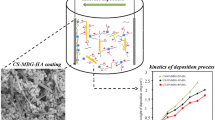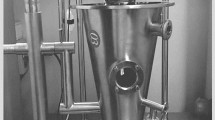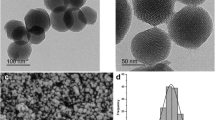Abstract
Chitosan particles loaded with dibasic calcium phosphate anhydrous (DCPA) is a promising strategy for combining antimicrobial and osteoconduction properties in regenerative medicine. However, mostly micrometer-sized particles have been reported in the literature, limiting their use and reducing their effect in the biomedical field. We have recently overcome this limitation by developing submicrometer-sized particles with electrospray technique. The objective of this study was to understand how the process parameters control the size and properties of submicrometer chitosan particles loaded with DCPA. Solutions of 10 mg/mL chitosan and 2.5 mg/mL DCPA in a 90% acetic acid were electrosprayed under three distinct flow rate conditions: 0.2, 0.5, and 1.0 mL/h. The particles were crosslinked in a glutaraldehyde atmosphere and characterized in terms of their morphology, inorganic content, zeta potential, and minimum inhibitory concentration (MIC) against S. mutans. All conditions showed particles with two similar morphologies: one small-sized with a spherical shape and another larger-sized with a bi-concave shape. All generated a broad particle size distribution, with a similar mean size of ~ 235 nm. The addition of DCPA decreased the zeta potential for all the samples, but it was above 30 mV, indicating a low aggregation potential. The lower flow rate showed the worst efficacy for DCPA incorporation. Antimicrobial activity was greater in chitosan/DCPA particles with flow rate of 0.5 mL/h. It can be concluded that the flow rate of 0.5 mL/h presents the best compromise solution in terms of morphology, zeta potential, MIC, and inorganic content.
Graphical abstract







Similar content being viewed by others
References
Demarco FF, Correa MB, Cenci MS, Moraes RR, Opdam NJ. Longevity of posterior composite restorations: not only a matter of materials. Dent Mater. 2012;28(1):87–101.
Mouhyi J, Dohan Ehrenfest DM, Albrektsson T. The peri-implantitis: implant surfaces, microstructure, and physicochemical aspects. Clin Implant Dent Relat Res. 2012;14(2):170–83.
Zandi H, Petronijevic N, Mdala I, Kristoffersen AK, Enersen M, Rocas IN, Siqueira-Jr J:F, Orstavik D. Outcome of endodontic retreatment using 2 root canal irrigants and influence of infection on healing as determined by a molecular method: a randomized clinical trial. J Endod. 2019;45(9):1089–98 e5.
Ahlfeld T, Doberenz F, Kilian D, Vater C, Korn P, Lauer G, Lode A, Gelinsky M. Bioprinting of mineralized constructs utilizing multichannel plotting of a self-setting calcium phosphate cement and a cell-laden bioink. Biofabrication. 2018;10(4):045002:1–33.
Anusavice KJ, Zhang NZ, Shen C. Controlled release of chlorhexidine from UDMA-TEGDMA resin. J Dent Res. 2006;85(10):950–4.
Rathke A, Staude R, Muche R, Haller B. Antibacterial activity of a triclosan-containing resin composite matrix against three common oral bacteria. J Mater Sci Mater Med. 2010;21(11):2971–7.
Khvostenko D, Hilton TJ, Ferracane JL, Mitchell JC, Kruzic JJ. Bioactive glass fillers reduce bacterial penetration into marginal gaps for composite restorations. Dent Mater. 2016;32(1):73–81.
Khvostenko D, Mitchell JC, Hilton TJ, Ferracane JL, Kruzic JJ. Mechanical performance of novel bioactive glass containing dental restorative composites. Dent Mater. 2013;29(11):1139–48.
Buruiana T, Melinte V, Popa ID, Buruiana EC. New urethane oligodimethacrylates with quaternary alkylammonium for formulating dental composites. J Mater Sci Mater Med. 2014;25(4):1183–94.
Imazato S, Ma S, Chen JH, Xu HH. Therapeutic polymers for dental adhesives: loading resins with bio-active components. Dent Mater. 2014;30(1):97–104.
Liang X, Soderling E, Liu F, He J, Lassila LV, Vallittu PK. Optimizing the concentration of quaternary ammonium dimethacrylate monomer in bis-GMA/TEGDMA dental resin system for antibacterial activity and mechanical properties. J Mater Sci Mater Med. 2014;25(5):1387–93.
Li F, Wang P, Weir MD, Fouad AF, Xu HH. Evaluation of antibacterial and remineralizing nanocomposite and adhesive in rat tooth cavity model. Acta Biomater. 2014;10(6):2804–13.
Kim J-S, Shin D-H. Inhibitory effect on Streptococcus mutans and mechanical properties of the chitosan containing composite resin. Restor Dent Endod. 2013;38(1):36–42.
Costa EM, Silva S, Veiga M, Tavaria FK, Pintado MM. A review of chitosan’s effect on oral biofilms: perspectives from the tube to the mouth. J Oral Biosci. 2017;59(4):205–10.
Petri DF, Donega J, Benassi AM, Bocangel JA. Preliminary study on chitosan modified glass ionomer restoratives. Dent Mater. 2007;23(8):1004–10.
Di Martino A, Sittinger M, Risbud MV. Chitosan: a versatile biopolymer for orthopaedic tissue-engineering. Biomaterials. 2005;26(30):5983–90.
Yan N, Chen X. Don't waste seafood waste. Nature. 2015;524(7564):155–7.
Skrtic D, Antonucci JM, Eanes ED. Improved properties of amorphous calcium phosphate fillers in remineralizing resin composites. Dent Mater. 1996;12(5):295–301.
Chiari MD, Rodrigues MC, Xavier TA, de Souza EM, Arana-Chavez VE, Braga RR. Mechanical properties and ion release from bioactive restorative composites containing glass fillers and calcium phosphate nano-structured particles. Dent Mater. 2015;31(6):726–33.
Xu HH, Moreau JL. Dental glass-reinforced composite for caries inhibition: calcium phosphate ion release and mechanical properties. J Biomed Mater Res B Appl Biomater. 2010;92(2):332–40.
Jayasuriya AC, Bhat A. Optimization of scaled-up chitosan microparticles for bone regeneration. Biomed Mater. 2009;4(5):e055006.1-8.
Jayasuriya AC, Bhat A. Fabrication and characterization of novel hybrid organic/inorganic microparticles to apply in bone regeneration. J Biomed Mater Res A. 2010;93(4):1280–8.
Yunoki A, Tsuchiya E, Fukui Y, Fujii A, Maruyama T. Preparation of inorganic/organic polymer hybrid microcapsules with high encapsulation efficiency by an electrospray technique. ACS Appl Mater Interfaces. 2014;6(15):11973–9.
Randolph LD, Palin WM, Leloup G, Leprince JG. Filler characteristics of modern dental resin composites and their influence on physico-mechanical properties. Dent Mater. 2016;32(12):1586–99.
Tanaka CB, Lopes DP, Kikuchi LNT, Moreira MS, Catalani LH, Braga RR, Kruzic JJ, Gonçalves F. Development of novel dental restorative composites with dibasic calcium phosphate loaded chitosan fillers. Dent Mater. 2020;36(4):551–9.
Sridhar R, Ramakrishna S. Electrosprayed nanoparticles for drug delivery and pharmaceutical applications. Biomatter. 2013;3(3).
Thien DVH, Hsiao SW, Ho MH. Synthesis of electrosprayed chitosan nanoparticles for drug sustained release. Nano LIFE. 2012;2(1):1–11.
Lim SS, Chai CY, Loh HS. In vitro evaluation of osteoblast adhesion, proliferation and differentiation on chitosan-TiO. Mater Sci Eng C Mater Biol Appl. 2017;76:144–52.
Aydınoğlu A, Yoruç ABH. Effects of silane-modified fillers on properties of dental composite resin. Mater Sci Eng C Mater Biol Appl. 2017;79:382–9.
CLSI. Clinical and laboratory standards institute standards development policies and process 2013.
Hazehara-Kunitomo Y, Hara ES, Ono M, Aung KT, Komi K, Pham HT, Akiyama K, Okada M, Oohashi T, Matsumoto T, Kuboki T. Acidic pre-conditioning enhances the stem cell phenotype of human bone marrow stem/progenitor cells. Int J Mol Sci. 2019;20(5):e1097. 1-10.
Gonsalves AA, Araújo CRM, Soares NA, Goulart MOF, Abreu FC. Diferentes estratégias para a reticulação de quitosana. Quim Nova. 2011;34(7):1215–23.
Mendes AA, Oliveria PC, Castro HF, Giordano RLC. Aplicação de quitosana como suporte para a imobilização de enzimas de interesse industrial. Quim Nova. 2011;34(5):831–40.
Odaci D, Timur S, Telefoncu A. A microbial biosensor based on bacterial cells immobilized on chitosan matrix. Bioelectrochemistry. 2009;75(1):77–82.
Gomez-Mascaraque LG, Sanchez G, Lopez-Rubio A. Impact of molecular weight on the formation of electrosprayed chitosan microcapsules as delivery vehicles for bioactive compounds. Carbohydr Polym. 2016;150:121–30.
Kawakami K, Sumitani C, Yoshihashi Y, Yonemochi E, Terada K. Investigation of the dynamic process during spray-drying to improve aerodynamic performance of inhalation particles. Int J Pharm. 2010;390(2):250–9.
Zhang S, Kawakami K. One-step preparation of chitosan solid nanoparticles by electrospray deposition. Int J Pharm. 2010;397(1-2):211–7.
Songsurang K, Praphairaksit N, Siraleartmukul K, Muangsin N. Electrospray fabrication of doxorubicin-chitosan-tripolyphosphate nanoparticles for delivery of doxorubicin. Arch Pharm Res. 2011;34(4):583–92.
Klein, M. P.; Nunes, M. R.; Rodrigues, R. C.; Benvenutti, E. V; Costa, T. M. H.; Hertz, P. F.; Ninow, J. L. Effect of the support size on the properties of β-galactosidase immobilized on chitosan: advantages and disadvantages of macro and nanoparticles. Biomacromolecules 2012; 13(8):2456–2464. https://doi.org/10.1021/bm3006984.
Michailidou G, Ainali NM, Xanthopoulou E, Nanaki S, Kostoglou M, Koukaras EN, Bikiaris DN. Effect of poly(vinyl alcohol) on nanoencapsulation of budesonide in chitosan nanoparticles via ionic gelation and its improved bioavailability. Polymers (Basel). 2020;12(5):1101. https://doi.org/10.3390/polym12051101.
Shetta A, Kegere J, Mamdouh W. Comparative study of encapsulated peppermint and green tea essential oils in chitosan nanoparticles: encapsulation, thermal stability, in-vitro release, antioxidant and antibacterial activities. Int. J. Biol. Macromol. 2019;126:731–42. https://doi.org/10.1016/j.ijbiomac.2018.12.161.
Zhou H, Yang L, Gbureck U, Bhaduri SB, Sikder P. Monetite, An important calcium phosphate compound–Its synthesis, properties and applications in orthopedics. Acta Biomater. 2021;127:41–55. https://doi.org/10.1016/j.actbio.2021.03.050.
Wang X, Ye J, Wang Y. Hydration mechanism of a novel PCCP + DCPA cement system. J Mater Sci Mater Med. 2007;19(2):813–6. https://doi.org/10.1007/s10856-006-0029-6.
Clogston JD, Patri AK. Zeta potential measurement. Methods Mol Biol. 2011;697:63–70.
Salopek B, Krasic D, Filipovic S. Measurement and application of zeta-potential. Rudarsko-geoloiko-naftni zbornik. 1992;4:147–51.
Alqahtani FY, Aleanizy FS, Tahir EE, Alquadeib BT, Alsarra IA, Alanazi JS, Abdelhady HG. Preparation, characterization, and antibacterial activity of diclofenac-loaded chitosan nanoparticles. Saudi Pharm J. 2019;27(1):82–7.
Wiarachai O, Thongchul N, Kiatkamjornwong S, Hoven VP. Surface-quaternized chitosan particles as an alternative and effective organic antibacterial material. Colloids Surf B Biointerfaces. 2012;92:121–9.
Stefano C, Gianguzza A, Piazzese D, Sl S. Speciation of chitosan–phosphate and chitosan–nucleotide systems in NaCI aqueoussolution. Chemical Speciation & Bioavailability. 2015;22(2):99–107.
Goy RC, Britto D, Assis OBG. Review of the antimicrobial activity of chitosan. Polímeros: Ciência e Tecnologia. 2009;19(3):241–7.
Kong M, Chen XG, Xing K, Park HJ. Antimicrobial properties of chitosan and mode of action: a state of the art review. Int J Food Microbiol. 2010;144(1):51–63.
Perinelli DR, Fagioli L, Campana R, Lam JKW, Baffone W, Palmieri GF, Casettari L, Bonacucina G. Chitosan-based nanosystems and their exploited antimicrobial activity. Eur J Pharm Sci. 2018;117:8–20.
Davey KR. Modelling the combined effect of temperature and pH on the rate coefficient for bacterial growth. Int J Food Microbiol. 1994;23(3-4):295–303.
Castillo A, Rubiano S, Gutiérrez J, Hermoso A, Liébana J. Post-pH effect in oral streptococci. Clin Microbiol Infect. 2000;6(3):142–6.
Sarwar A, Katas H, Zin NM. Antibacterial effects of chitosan–tripolyphosphate nanoparticles: impact of particle size molecular weight. J Nanopart Res. 2014; 16:e2517.1-14.
Acknowledgements
The authors thank the São Paulo Research Foundation, Brazil (FAPESP, 2016/13114-2), along with the FAPESP-UNSW Joint Research Grant Program, Brazil-Australia (FAPESP, 2017/50290-6) for funding this project.
Author information
Authors and Affiliations
Contributions
Lopes DP – chitosan purification, particles synthesis, TGA and drafting of the manuscript
Freitas SEM – MIC analysis, and drafting of the manuscript
Tanaka CB - conception, data interpretation and drafting of the manuscript
Delechiave G – zeta potential, DSC, and drafting of the manuscript
Kikuchi LNT – ninhydrin assay, FTIR and drafting of the manuscript
Braga RR - conception, data interpretation and reviewing of the manuscript
Kruzic JJ - conception, data interpretation and reviewing of the manuscript
Boaro LCC – MIC analysis, data interpretation and reviewing of the manuscript
Catalani LH - conception, data interpretation and reviewing of the manuscript
Moreira SM – ICO-OES, data interpretation and reviewing of the manuscript
Gonçalves F – MEV, statistical analysis conception, data interpretation and reviewing of the manuscript
Corresponding author
Ethics declarations
Conflict of Interest
The authors declare no competing interests.
Additional information
Publisher’s Note
Springer Nature remains neutral with regard to jurisdictional claims in published maps and institutional affiliations.
Rights and permissions
Springer Nature or its licensor (e.g. a society or other partner) holds exclusive rights to this article under a publishing agreement with the author(s) or other rightsholder(s); author self-archiving of the accepted manuscript version of this article is solely governed by the terms of such publishing agreement and applicable law.
About this article
Cite this article
Lopes, D.P., Freitas, S.R.M., Tanaka, C.B. et al. Synthesis of Submicrometric Chitosan Particles Loaded with Calcium Phosphate for Biomedical Applications. AAPS PharmSciTech 24, 56 (2023). https://doi.org/10.1208/s12249-023-02517-8
Received:
Accepted:
Published:
DOI: https://doi.org/10.1208/s12249-023-02517-8




